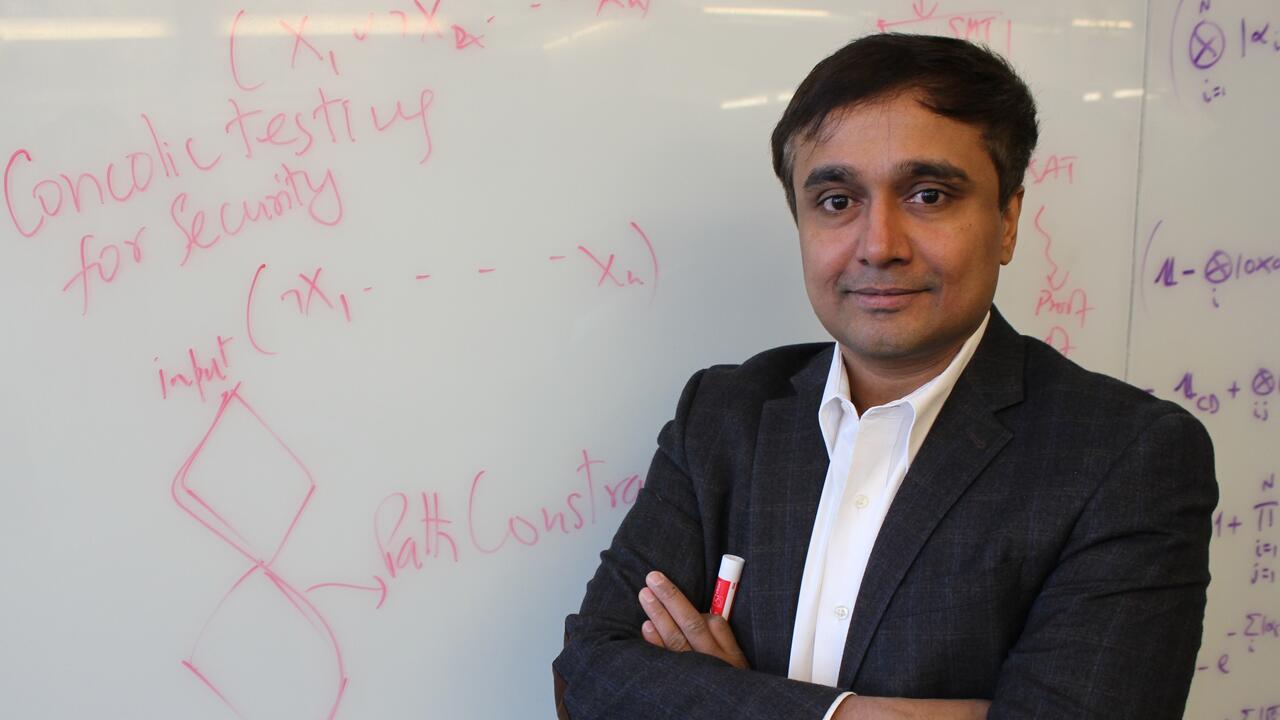
Cybersecurity researcher takes aim at the ‘impossible’
Vijay Ganesh has developed cybersecurity programs to help software developers fend off hacker attacks

Vijay Ganesh has developed cybersecurity programs to help software developers fend off hacker attacks
By Julie Stauffer Faculty of EngineeringDefending against memory buffer overflow attacks is a daunting proposition for computer software developers.
Failing to carefully specify appropriate inputs opens the door for hackers to insert malicious code by overwhelming a system’s memory space with unanticipated inputs.
But how do you plan for every possible type of input a hacker could use? You turn to Vijay Ganesh.
An electrical and computer engineering professor at the University of Waterloo, Ganesh has developed a number of SMT/SAT solvers: cybersecurity programs that generate test inputs, letting developers pinpoint and address vulnerabilities before their software hits the market.
When he started his research in the early 2000s, people told him the challenge was so impossibly complex that he was wasting his time. You can never come up with an algorithm to solve these kinds of equations, his colleagues said, since the number of potential inputs is exponentially large.
Ganesh proved them wrong.
Although their observation is true in theory, in most cases the number of possibilities can be narrowed down to a manageable amount based on the fact that software isn’t a random collection of code.
“What we’re saying is that often the kind of constraints we get from practical applications tend to have a lot of structure to them,” Ganesh explains. “At first glance, it might seem that the search space is two to the millionth for some of these formulas, but in practice it would be much smaller because of all the structures you can leverage.”
Ganesh was lured to Waterloo in 2012 after completing a PhD at Stanford University and a research position at the Massachusetts Institute of Technology (MIT). It was an easy choice for him.
“Waterloo has a fantastic reputation in America,” he says. “Whenever I go back to MIT or Stanford and say I’m teaching at Waterloo, they’re very proud of me.”
Since arriving, Ganesh has racked up distinctions including an Ontario Early Researcher Award, an IBM Faculty Award and his second Google Research Award, not to mention several best-paper honours. He attributes much of that success to the quality of his research team.
“I have an absolutely fantastic group of students,” he says.
Recognition has opened doors to collaborations with the likes of Google, IBM and Microsoft, where Ganesh’s cybersecurity algorithms are helping ensure their software is more robust, reliable and secure.
While seeing his work applied in practical settings has been very satisfying, Ganesh is also excited by more esoteric applications.
“There are problems that mathematicians would like to solve but they cannot by human reasoning alone,” he says. “My long-term goal in the next five years is to apply these tools to prove theorems in mathematics that are otherwise difficult or perhaps even impossible for humans alone to prove.”
It wouldn’t be the first time Ganesh has tackled intractable problems and triumphed.

Engineering master's student Nayeema Nonta (left), one of the three paper authors, and her supervisor, Dr. Sirisha Rambhatla, in a large server room with the computer power needed to develop their new LLM training technique. (University of Waterloo)
Read more
Waterloo researchers develop highly efficient AI training system that paves the way for cheaper, greener “intelligent partners”

Read more
Engineering researchers team up to tackle the plastics pollution problem with microbial innovation and engineering design

Read more
15 University of Waterloo researchers have been named to the annual Highly Cited Researchers™ list for significant contributions to their specific fields of research
Read
Engineering stories
Visit
Waterloo Engineering home
Contact
Waterloo Engineering
The University of Waterloo acknowledges that much of our work takes place on the traditional territory of the Neutral, Anishinaabeg, and Haudenosaunee peoples. Our main campus is situated on the Haldimand Tract, the land granted to the Six Nations that includes six miles on each side of the Grand River. Our active work toward reconciliation takes place across our campuses through research, learning, teaching, and community building, and is co-ordinated within the Office of Indigenous Relations.